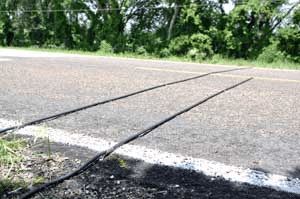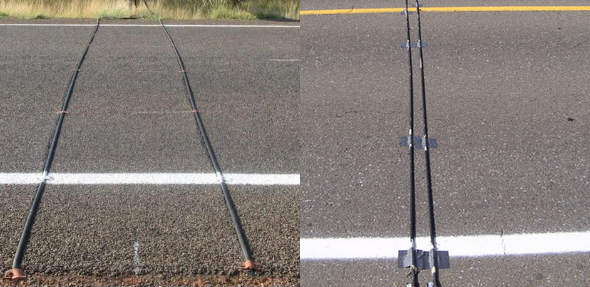You’re driving around on a relatively well-paved road. The road has a double-yellow line, suggesting that it’s not a road in which kids should be playing or where there’s a high likelihood of a pedestrian suddenly jutting out into the street.

You can drive on the faster side without too much additional risk.
But then, as you speed on at 35 miles per hour, you hear the little “ba-dump ba-dump” as you glide over those two little black bumps in the road.
What are those doing there, anyway? They’re obviously not there to slow you down — they’re simply too small.
They’re called pneumatic road tubes, and they’re designed to count how many cars use the road.
Here’s how they work:
Every time a vehicle’s tires hit the tube, it sends a burst of air that triggers a switch, which then produces an electrical signal that’s recorded by a counter device.

Some tubes are installed temporarily, usually for about a day, and others are permanent. Rechargeable batteries powered by something like lead acid or gel keep the rig running.
Who’s counting?
Measuring road usage is important for a few reasons — it can help municipalities figure out which arteries are the most critical ones in town, for example.
And it can help estimate potential traffic problems, too.
Urban planners typically have a decent idea of how many cars should be using a certain road over a specific time period, and road boards often use these estimates in making decisions. Having actual data of road use validates the estimates or, when needed, corrects them.
But there’s one other use that you, the driver, may not be as fond of: pneumatic road tubes can help catch people driving over the speed limit.
By doing a little bit of math, engineers can figure out the speed any given car is traveling — you just take the distance between the tubes, divide by the time between hitting the tubes, factor-label method it up, and there you go.
That said, it’s unlikely the tubes will, directly, earn you a speeding fine. However, the tubes aren’t used to catch individual speeders. But don’t be surprised if they lead to speed traps.
The speed tracking is used for information gathering purposes which can then help determine if changes to the speed limit or to help police officers figure out where to wait to catch someone in the act.
So, next time you see a pair of these tubes, it may be worth slowing down a bit anyway.



















